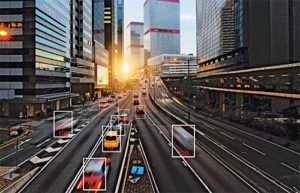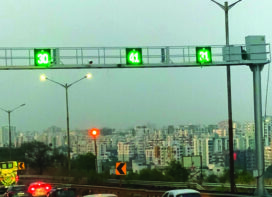The IoT is changing the way we view video security, quite literally. Now, cameras need to be so much more than devices with which to simply capture images; they need to be far smarter than that. Today cameras are becoming an integral part of the vast digital connectivity infrastructure, specifically, advancements in intelligent cameras have contributed to positive results in many areas that can help improve road safety
 With increased urbanization and increased vehicular traffic, cities everywhere are battling with an inability to build enough infrastructure. While the government has been laying emphasis on building roads, bridges & underpasses and creating alternative modes of mass public transport systems, this may not be enough to address the traffic congestion. Traffic management has always posed a challenge in India and it may continue to become more difficult with every passing day unless we start building some intelligence into the way we look at resolving these issues. The solution lies in leveraging advanced technologies and intelligent solutions. Some intelligent Traffic management systems are already being implemented in cities like Delhi, Bangalore and Chennai making an impact in the form of reduced congestion and less fatal accidents.
With increased urbanization and increased vehicular traffic, cities everywhere are battling with an inability to build enough infrastructure. While the government has been laying emphasis on building roads, bridges & underpasses and creating alternative modes of mass public transport systems, this may not be enough to address the traffic congestion. Traffic management has always posed a challenge in India and it may continue to become more difficult with every passing day unless we start building some intelligence into the way we look at resolving these issues. The solution lies in leveraging advanced technologies and intelligent solutions. Some intelligent Traffic management systems are already being implemented in cities like Delhi, Bangalore and Chennai making an impact in the form of reduced congestion and less fatal accidents.
For instance; Delhi Police has been working on several projects based on cutting-edge technology to improve Traffic management system in the city and check on errant drivers. It is planning to install a 3D radar-based Red-Light Violation Detection cameras (RLVD) system at 24 junctions across the city to monitor people jumping the red light.
Similarly, Bengaluru traffic police is getting about 350 new adaptive cameras in the next three months. Besides, the traffic police has also deployed about 1,000 cameras, 100 red-light violation detection cameras to capture and record signal jumping and 30 to 40 Number Plate Regulation (NPR) cameras with the capacity to recognise number plates from among thousands of vehicles. The police also has the software to recognise and record repeat offenders
Catching red-light violators and managing traffic at 159 busy junctions, Chennai city is set to get automated with the Corporation getting a nod to implement Red Light Violation Detection (RVLD) system by installing ANPR cameras under the Smart City programme.
The project will be executed under the intelligent traffic management system intelligent traffic management system (ITMS) for an integrated management of transport, to automate the process of traffic regulation, and to catch violators who over-speed, park illegally, or jump signals.
What is an intelligent cameras?
Cameras have now come to serve as the ‘optimized eye’ for Intelligent Traffic Systems, delivering highquality images even under the most challenging of conditions. With the rise of ANPR, also known as LPR (License Plate Recognition), as technological cornerstones of modern traffic systems, the importance of image quality is essential.
An intelligent video cameras is connected to a cloud that analyses livevideo content. Events captured by the cameras can instantly lead to desired actions. The ability to act without a human operator is what makes the cameras intelligent. The transition from ‘Smart to Intelligent cameras’ makes the analytics select only the necessary data to be saved for later investigation. Intelligent cameras can also recognize a license plate.
Intelligent cameras: Transforming the Transportation ecosystem
 Intelligent Traffic Cameras can detect traffic movements, detect violations, incidences, manage entry and exit of vehicles, manage parking everything automatically. Its application includes:
Intelligent Traffic Cameras can detect traffic movements, detect violations, incidences, manage entry and exit of vehicles, manage parking everything automatically. Its application includes:
• Smart city traffic enforcement (ITMS) especially used with Red Light Violation Detection Integrated with RTO: E-Challan.
• Parking Management to calculate the vehicle occupancy time for each parking slots.
• Entry/ Exit/ Tollbooth Vehicle Monitoring : This is a typical use case for what we call Video Analytics for Smart Buildings. Implementations include:
a) Comparing number plate with Black list and White list
b) Time spent by vehicle inside premises
c) Alert on vehicles that haven’t exited at the end of the day
d) Daily vehicle counting reports.
• Video incidence detection for highways (VIDS)
a) Illegal parking detection in no parking areas
b) Wrong way detection
c) Speeding detection
d) Sudden stop detection in the middle of the road indicating accident
e) Traffic classification into Congested, Stop & Go and Normal
f) Vehicle classification, colour detection, multi lane vehicle counting and reports
g) Throw of garbage or litter on the road
 TrafficInfraTech Magazine Linking People Places & Progress
TrafficInfraTech Magazine Linking People Places & Progress


